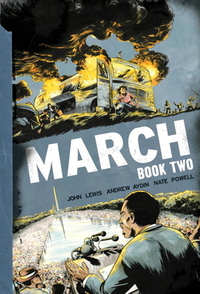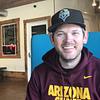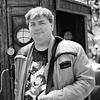Take a photo of a barcode or cover
informative
inspiring
This book was much more cohesive than the first, and I had adjusted to the style a bit better. I thoroughly enjoyed this sequel - I feel like it portrayed the courage of these activists clearly.
Even more powerful and moving than the first book. The freedom rides, the protests, the arrests, the time spent in jail - it all reminds me of something out of the New Testament. I'm sure Lewis would appreciate the comparison to the early Christians. I knew embarrassingly little about the history of the freedom rides and the marches, and the amount of violence perpetrated on those involved was truly shocking. The most frustrating was the violence supported and endorsed by the police, the local government, and in some cases, the federal government. The determination of the riders, protestors, and marchers is truly something to behold - they fought (figuratively, peacefully) for every inch of progress, and weren't going to slow down no matter how many times it would have been reasonable and understandable to do so. Sometimes this all seems like ancient history, but we keep being reminded of how little some things have changed, which is truly heartbreaking. Leaders like Lewis continue to be vital.
John Lewis' story continues, with a focus on events from the early 1960s--the Freedom Rides, the big six, and the 1963 March on Washington--interspersed with scenes from Barack Obama's inauguration.
Such a powerful and inspirational book. I can't even begin to imagine what life was like for Freedom Riders and other protesters, and I am beyond grateful that brave people are willing to risk so much for what they know is right. Looking forward to Book 3.
Strong graphic novel memoir, a continuation of John Lewis' story of his involvement in the civil rights movement in the 60s. This installment includes the violence faced by the Freedom Riders and other non-violent protestors, and culminates in the March on Washington, closing on a dark note with a church bombing. Lewis and his collaborators carefully depict some of the political differences among the civil rights leaders. I found it difficult at times to 'read' the pictures - tiny print, lots of characters, old eyes - but I thought it was a powerful didactic instrument.
This tome is so much more powerful than the first one. Mostly because the non violent protests organized by the SNCC are now faced with more and more violence the deeper they go in the South.
I still struggle to comprehend that these events happened in the 60s. It is not that long ago... it's so incredible to see how the system fed the narrative. As I'm not American, I had a very limited knowledge of what happened, and this is definitely a great educational series, very honest, and raw.
If you need to educate yourself on the Civil Right Movement, these 3 tomes are really excellent.
I still struggle to comprehend that these events happened in the 60s. It is not that long ago... it's so incredible to see how the system fed the narrative. As I'm not American, I had a very limited knowledge of what happened, and this is definitely a great educational series, very honest, and raw.
If you need to educate yourself on the Civil Right Movement, these 3 tomes are really excellent.
challenging
dark
emotional
hopeful
informative
inspiring
slow-paced
I thought I knew about the 1961 Freedom Rides and the violence the participants faced. I thought I knew about the 1963 March on Washington and who participated. This book proved that I had much to learn.
The single most impressive thing about John Lewis writing his memoirs as a graphic novel is the number of people who he gives credit to in the story. Every rider who climbed on that first bus with him gets a little back story. Every SNCC member who helped him draft and revise his famous speech gets a shout out.
In my head, I’d tied JFK so much to the civil rights movement (chronologically) that I never fully appreciated how much he met with the black leaders, including the young John Lewis, while simultaneously dragging his feet. His response was infinitely better than the current presidential response to civil unrest, but it could still also have been so much better.
The single most impressive thing about John Lewis writing his memoirs as a graphic novel is the number of people who he gives credit to in the story. Every rider who climbed on that first bus with him gets a little back story. Every SNCC member who helped him draft and revise his famous speech gets a shout out.
In my head, I’d tied JFK so much to the civil rights movement (chronologically) that I never fully appreciated how much he met with the black leaders, including the young John Lewis, while simultaneously dragging his feet. His response was infinitely better than the current presidential response to civil unrest, but it could still also have been so much better.







